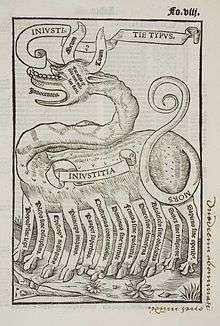Injustice
Injustice is a quality relating to unfairness or undeserved outcomes. The term may be applied in reference to a particular event or situation, or to a larger status quo. In Western philosophy and jurisprudence, injustice is very commonly—but not always—defined as either the absence or the opposite of justice.[1][2][3]

The sense of injustice is a universal human feature, though the exact circumstances considered unjust can vary from culture to culture. While even acts of nature can sometimes arouse the sense of injustice, the sense is usually felt in relation to human action such as misuse, abuse, neglect, or malfeasance that is uncorrected or else sanctioned by a legal system or fellow human beings.
The sense of injustice can be a powerful motivational condition, causing people to take action not just to defend themselves but also others who they perceive to be unfairly treated. Injustice within legal or societal standards are sometimes referred to as a two-tiered system.[4]
Relationship with justice
Professor Judith Shklar has written that Western philosophers tend to spend much more time discussing the concept of 'justice' rather than 'injustice'. On the other hand, she states both historical writing and fiction use instances of injustice as subject matter far more often than justice.[5]
In philosophy and jurisprudence, the dominant view has been that injustice and justice are two sides of the same coin—that injustice is simply a lack of justice. This view has been challenged by professors including Judith Shklar, Thomas W Simon and Eric Heinze, who consider that justice and injustice are independent qualities. So, in this minority view, you can increase the justice of a situation without reducing the injustice. Heinze has even gone as far as to argue that an increase in justice can actually cause an increase in injustice.[2][3][5]
A relatively common view among philosophers and other writers is that while justice and injustice may be interdependent, it is injustice that is the primary quality. Many writers have written that, while it is hard to directly define or even perceive justice, it is easy to demonstrate that injustice can be perceived by all.[6] According to von Hayek, the earliest known thinker to state that injustice is the primary quality was Heraclitus, whose view was echoed by Aristotle and dozens of others down the centuries. Hayek said that writers often express the idea that injustice is the primary concept "as though it were a new discovery", suggesting the view is rarely directly expressed in theories on Justice. But Hayek went on to say that legal positivism has proved that injustice, not justice, is the primary quality.[7]
Sense of injustice

Scholars including Judith Shklar, Edmond Cahn and Barrington Moore, Jr. have surveyed anthropological and historical work on injustice, concluding that the sense of injustice is found everywhere there are men and women; it is a human universal.[5][9][10] These writers, and others like Simone Weil, Elizabeth Wolgast and Thomas W Simon, hold that the sense of injustice is a powerful motivational condition — unlike the sense of justice which tends to be conceived in more abstract ways, and tends to inspire contemplation rather than action.[2][11][12][13]
Cahn held that, for evolutionary reasons, humans who witness others being subjected to injustice can respond as though it was an act of aggression towards themselves. There can be an immediate, visceral activation of the flight or fight system. As Dr. Martin Luther King Jr. puts it "injustice anywhere is a threat to justice everywhere".[14] Spinner-Halev spoke about enduring injustices where it will still persist to this day without any action to address them.[15] A 2012 study published in Psychological Science found that even babies have a sense of injustice and dislike having it violated, even when they witness events that do not directly effect them.[16][17]
In the field of jurisprudence, Cahn has argued that it is an important skill for lawyers to know how to rouse a jury's sense of injustice — something best done by appeals to the particular, not by abstractions or boilerplate type statements. Barrington Moore asserts that reasons why populations often submit to oppression for long periods of time is that they consider it inevitable and so their sense of injustice is not aroused. He says that a widely shared sense of injustice is an essential, though not sufficient, cause of rebellion. Writers including Simone Weil, Elizabeth Wolgast and Judith Shklar have said that an aroused sense of injustice can be an essential prerequisite to action needed for protecting the weak and afflicted.[5][9][10][11][12]
Causes
A common cause of injustice is human selfishness. As Plato described at length in The Republic, people will often commit acts of injustice when they calculate it is in their interests to do so.[3] Plato also adds that "The highest reach of injustice is to be deemed just when you are not". Human injustice is not always caused by attempt to gain unfair advantage or malice; it may be simply the result of the flawed human decision making. For example, studies have found that judges sitting on review boards are less likely to reach decisions favorable to applicants depending on how long it is since the judges had their last food break.[18][19] Misuse and abuse with regard to a particular case or context may represent a systemic failure to serve the cause of justice (cf. legal vacuum).[2][9]
Examples
The Innocence Project provides a wealth of cases in which the U.S. justice system prosecuted and convicted the wrong person.
Popular culture
- The Life of Emile Zola (1937), about the conviction of Émile Zola
- Beyond Reasonable Doubt (1982), about the conviction of Arthur Allan Thomas
- The Great Gold Swindle (1984), about the conviction of the Mickleberg brothers
- The Thin Blue Line (1988), about the conviction of Randall Dale Adams
- In the Name of the Father (1993), about the conviction of Gerry Conlon of the Guildford pub bombings
- The Fugitive (1993)
- The Crucible (1996), about the Salem witchcraft trials
- The Hurricane (1999), about the conviction of Rubin Carter
- The Great Mint Swindle (2012), also about the conviction of the Mickleberg brothers
- Making a Murderer (2015), about the conviction of Steven Avery
See also
- Rule According to Higher Law
- Rule of law
Notes and references
- McCoubrey, Hilaire and White, Nigel D. Textbook on Jurisprudence. Second Edition. Blackstone Press Limited. 1996. ISBN 1-85431-582-X. Page 276.
- Thomas W Simon (1995). "passim, see esp Chpt 1, 'Injustice versus Justice'". Democracy and Social Justice. Rowman & Littlefield. ISBN 978-0847679386.
- Eric Heinze (2012). "passim, see esp Chpt 1, 'Nietzsche's echo'". The Concept of Injustice. Routledge. ISBN 978-0415524414.
- "Want to Know How to Build a Better Democracy? Ask Wikipedia". Wired. 2019-04-07.
- Judith N. Shklar (1992). "passim, see esp Chpt 1, 'Giving Injustice its due'". The Faces of Injustice. Yale University Press. ISBN 978-0253200556.
- Edmond N. Cahn (1946). "Justice, Power and Law". Yale Law Journal. 55 (2): 336–364. doi:10.2307/792700. JSTOR 792700.
- See Chapter 8 "THE QUEST FOR JUSTICE" in Vol 2 of von Hayeks's The mirage of social justice (University of Chicago Press, 1978). For a list discussing dozens of writers who have stated down the centuries that injustice, not justice, is the primary concept, look out for the long footnote under the sub heading "Rules of just conduct are generally prohibitions of unjust conduct"
- Mike Widener (July 28, 2010), More images in our Flickr galleries, Yale Law Library
- Edmond N Cahn (1975). The sense of injustice. Indiana University Press. pp. passim, see esp pp 24–26, 106. ISBN 978-0253200556.
- Barrington Moore, Jr. (1978). Injustice: The Social Bases of Obedience and Revolt. Palgrave Macmillan. pp. passim. ISBN 978-0333247839.
- Richard H Bell (1998). "Chpt 3". Simone Weil: The Way of Justice as Compassion. Rowman & Littlefield. ISBN 978-0847690800.
- Elizabeth Wolgast (1987). The Grammar of Justice. Cornell University Press. pp. 103. ISBN 978-0801494024.
- Barnett, Clive. The Priority of Injustice: Locating Democracy in Critical Theory. (Athens, GA: University of Georgia Press, 2017). ISBN 978-0820351520
- Martin Luther King, Jr., Letter from a Birmingham Jail (1963).
- Spinner-Halev, Jeff (2012). Enduring Injustice. Cambridge University Press.
- Maia Szalavitz (2012-02-20). "Even Babies Can Recognize What's Fair: Babies as young as 19 months are affronted when they see displays of injustice". Time. Retrieved 2016-07-14.
- Stephanie Sloane, Renée Baillargeon and David Premack (2012). "Do Infants Have a Sense of Fairness?". Psychological Science. 23 (2): 196–204. doi:10.1177/0956797611422072. PMC 3357325. PMID 22258431.
- "We find that the percentage of favorable rulings drops gradually from ≈65% to nearly zero within each decision session and returns abruptly to ≈65% after a break." Shai Danzigera; Jonathan Levav; Liora Avnaim-Pessoa (11 April 2011). "Extraneous factors in judicial decisions". Proceedings of the National Academy of Sciences of the United States of America. 108 (17): 6889–92. Bibcode:2011PNAS..108.6889D. doi:10.1073/pnas.1018033108. PMC 3084045. PMID 21482790.
- For more on the substantial difference in judges' decisions depending on time since last food break, see chpt 3 of Thinking, Fast and Slow.
Further reading
- Barnett, Clive. The Priority of Injustice: Locating Democracy in Critical Theory. (Athens, GA: University of Georgia Press, 2017). ISBN 978-0820351520
- McCoubrey, Hilaire and White, Nigel D. Textbook on Jurisprudence. Second Edition. Blackstone Press Limited. 1996. ISBN 1-85431-582-X. Chapter 14 ("The Concept of Injustice").
- Roberts, Rodney C. (2005). Injustice and Rectification. Peter Lang. ISBN 0820478601
- Jeff Spinner-Halev (2012). Enduring Injustice. Cambridge University Press. ISBN 1107017513